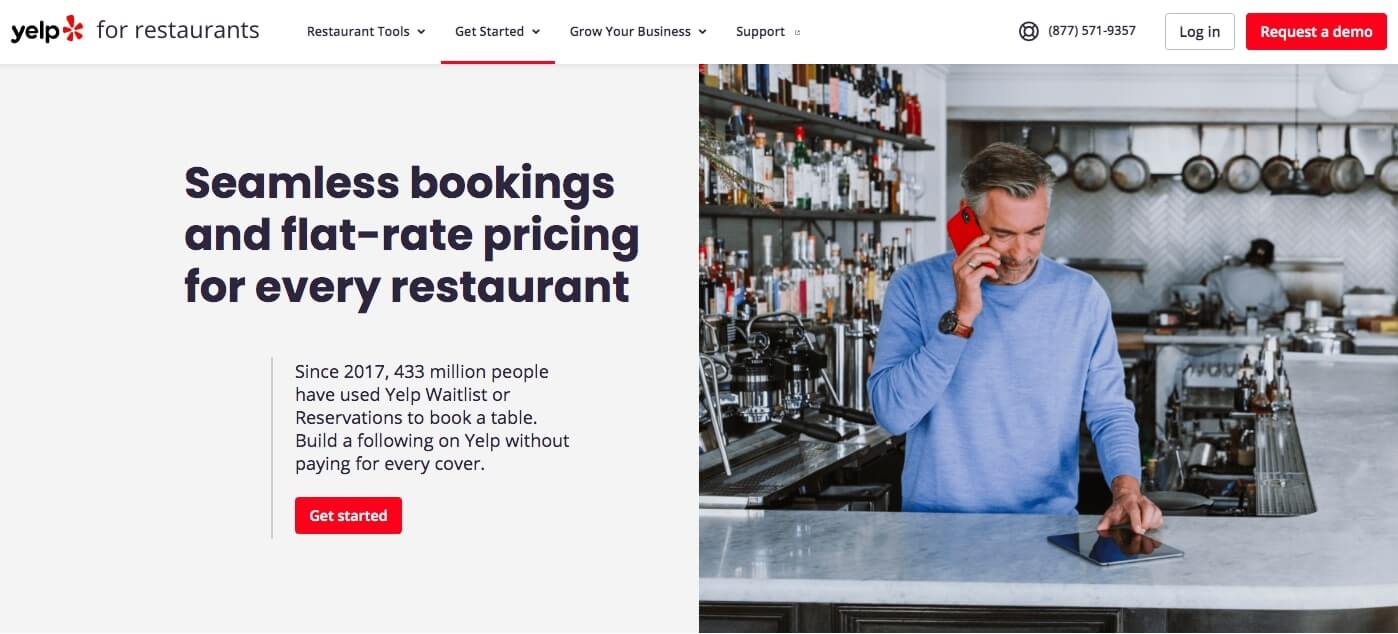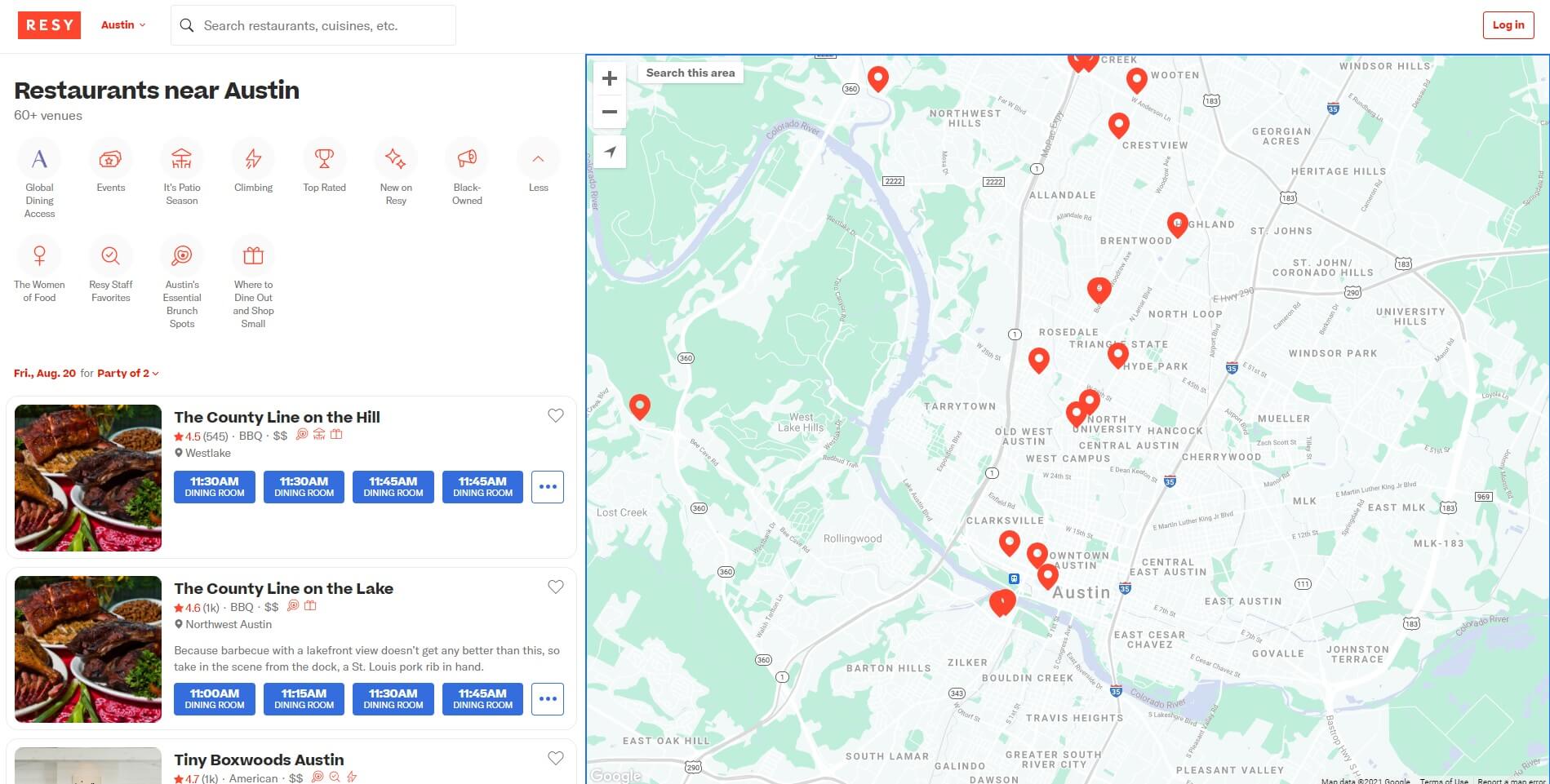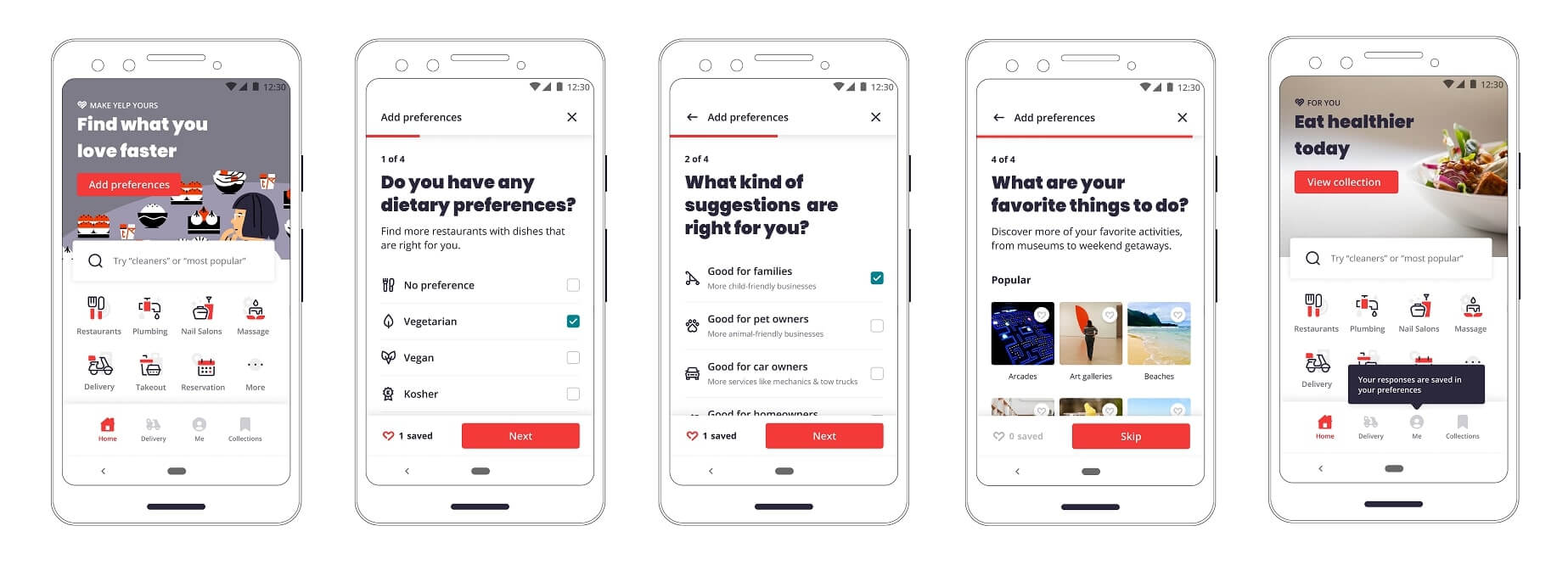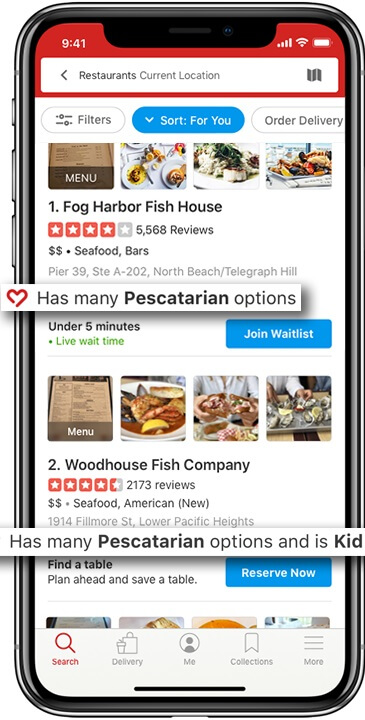Yelp vs. Resy: Which one is right for your restaurant?
Update: As of October 26, 2021 Resy has removed their app from the Google Play Store and discontinued updates for the Android app indefinitely.
Skip the article and turn takeaways into action by scheduling a call with our team.
Managing a restaurant is a fast-paced and fulfilling job where owners wear many hats, especially since the pandemic. Restaurant owners and managers have to handle the traditional front of house issues like table management and no-shows, all while managing pricing, payroll, and inventory.
That’s nothing new, but these days, managers and operators have to be software masters as well. You have to pick which system is best for point of sale, online reservations, and so on. This often leads to a buyer’s dilemma: Which is the best restaurant software? For example, what’s the difference between Yelp vs. Resy?
So, let’s dive in and have a look at the two systems—what makes them tick, how they’re different, and how they can help restaurants.
The basics: What do Yelp and Resy offer restaurants?

Both Yelp for Restaurants and Resy help restaurants manage plenty of aspects of their business—but they do it differently.
Yelp’s offerings
Yelp offers three robust services for restaurants:
- Yelp for Restaurants, the FOH integrated software package that includes Yelp Reservations and Waitlist
- Yelp Connect, a platform to help restaurants boost their image by sharing news, posts, and updates directly to their Yelp business page
- Yelp Marketing, which helps businesses advertise to potential customers at prices as low as $5 per day

Yelp for Restaurants’s Standard package offers two-way messaging, floor plan management, basic reservation management, SMS notifications, and online waitlisting.
The Plus package offers all that plus a top-notch reservation management system, a digital guestbook, and POS integration. The Plus system integrates Yelp Waitlist and Reservations in one tool. When you sign up, you’ll have full support from Yelp to get you on board with the help of a dedicated success manager.
The system also provides robust analytics, real-time communication with guests, and automated wait time updates to help reduce the impact of no-shows or hungry customers abandoning their spot in line.
The POS system also keeps track of guest info—things like birthdays, anniversaries, and even food preferences—to make guests feel fully appreciated.
The pricing system has flat rates that work like this:
- $249/month for the Standard platform
- $299/month for the Plus platform
- Special group pricing for Enterprise, for restaurants with 10+ locations
Yelp Connect is an additional feature that starts at $180 a month, and comes with a business page upgrade worth $120 when you sign up.
As a neat bonus to Yelp’s FOH software suite, Yelp for Restaurants offers the necessary hardware at no additional cost, which can help restaurants save on up-front costs. Considering that a new iPad costs at minimum $329 for the most basic model, this is actually a pretty significant bonus.
You can also use the iPad to help set up Yelp Kiosk, which essentially automates host services. Kiosk collects guest information and estimates accurate wait times, messages them when their table is ready, and answers questions that hosts would typically answer.
Resy’s offerings
Resy offers a systemic operating system (OS) that’s designed to help manage all aspects of a restaurant.
Their OS packages come in different tiers. Their basic OS offers reservations, waitlist, and table management as well as “Resy At Home Culinary Experiences,” which gives restaurants flexibility in customizing services for customers. You could create ticketed online cooking lessons, a virtual wine class, or a themed meal kit.

Higher tiers from ResyOS offer management features all the way from POS integration and customizable customer messaging to inventory management, menu management, sales tracking, analytics, and more.
Customers can book tables from either the Resy app or through their website, and can choose their preferred seating location as well. When guests make these reservations, their information is shared across all linked platforms, so servers and managers have info readily available from returning customers. Resy lets you track customer preferences so that servers can easily remember favorite drinks and dishes of their regulars.
Resy’s reservation and waitlist service offer automatic SMS messaging to confirm reservations and let guests know when a spot on the waitlist has opened up. A similar process takes place inside: The program can automatically assign guests to servers based on current workload.
Resy offers three monthly fee packages:
- Basic, at $249/month
- Pro, at $399/month
- Enterprise, at $899/month
Do note you only get customizable guest messaging and POS integration starting with the Pro plan. But with this plan you also get one-on-one onboarding and training on the product from the Resy team. For reference, all Yelp for Restaurants plans come with one-on-one onboarding.
With the Basic plan, they offer what they call “self-serve onboarding,” which means you’ll essentially need to train yourself to use the program.
With the Pro plan, restaurants can give customers a customizable survey after the meal. Analytics and guest info are stored for easy access afterwards. The Pro plan allows for two customized data and analytics reports per year, whereas the Enterprise version allows for unlimited reports.
The Pro plan also allows third-party reviews to appear on your restaurant’s page. It also allows for third-party pre-payment options.
Overall, the Pro plan offers significantly more options than the Basic plan, but at an additional $150/month. There’s a lot more room for flexibility with that plan, but it’s up to restaurateurs to decide if they would actually use those services or if they’d be superfluous.
Oh, and one more thing in favor of both services: Do note that neither Yelp for Restaurants nor Resy charges per cover, as opposed to simpler reservation systems like OpenTable.
Yelp vs. Resy: Restaurant reservations

One of the functions of each platform is to work as a restaurant reservation system. At the simplest level, a reservation platform helps potential customers make online reservations at local restaurants—or even not-so-local, if people want to plan in advance for a trip.
Both Yelp and Resy allow guests to add themselves to waitlists via their mobile app. One key difference between the services, however, is the party size allowed. Resy only allows 1-4 guests per party on their waitlist, whereas Yelp allows parties of six or more. Both apps allow parties to choose their seating preference.
Resy also has restrictions on how close a customer has to be to the restaurant to add themselves to a waitlist. The distance limit varies by city—for example, 1 mile in New York and Philadelphia or 5 miles in Austin or Seattle. The highest distance allowed is 5 miles, gauged by a phone’s location.
Yelp has no such restrictions, and diners can add themselves to a waitlist either via the Yelp Waitlist app or via Yelp.com. Instead, customers add their expected arrival time and their party size—and voila, that’s that.
App reviews
A solid end-user app is crucial for any integrated system to work for your restaurant. Of course, both Yelp and Resy offer end-user apps, but there are some significant differences between them.
Restaurant owners know the impact reviews can have on businesses, and sometimes reviews just don’t go the right way. That said, the reviews of Resy’s Android app average just 1 star. Reviewers mention the glitchy user interface and the inability to search for restaurants, which means you lose out on their business. However, their iOS reviews are much better.
Yelp’s Android app, by comparison, averages 4 stars from reviewers. A common complaint from users is they were prompted to download the app when they were on the mobile site. However, Apple users don’t have the same issue.
App functionality
Resy and Yelp’s app functionality for the user are drastically different.
Resy focuses on reservations and waitlists in their end user app, displaying local partner restaurants in many major metropolitan areas across the world. Guests will enter a phone number and choose their party size, table type, and time.
The app allows for searches and filters, and the web app has some robust and interesting features—including searching for Resy staff favorites, top-rated restaurants, Black-owned or female-led restaurants, and more. You can make reservations long in advance, though not all restaurants will accept reservations for more than a few weeks in the future.

While Resy does show reviews based on a star system, users can’t read them. However, Resy does provide information in the “About” and “Need to know” sections, as well as an occasional “Why we like it” section.
Restaurants can provide examples of their menu in “Menu highlights” but users will have to find the restaurant site to get a full view of the menu.
Their search function works well but can demonstrate a fairly narrow reach. The web app only returned seven Mexican restaurants in Austin, Texas, for example. Compare that to hundreds on Yelp, and users may feel like they’re missing out on some vital information.
Overall, you can use Resy’s web or mobile apps to make reservations, get on waitlists, find info like phone numbers, locations, and websites, or book delivery via a link to third-party apps. But user interactions with the restaurant via the app are limited.

Let’s compare all of that to Yelp. Yelp’s end user app is far more than a one-trick pony. Yes, customers can make restaurant reservations and get on waitlists locally, just like with Resy. They can also further engage with restaurants in many other ways: order takeout or delivery right on the app, read menus, find current deals, and read from millions of reviews.
Users can help the app get to know them and their preferences as well, including dietary preferences.

Users who have added themselves to a waitlist will receive updates on their wait time using a sophisticated algorithm. Cancellations will automatically bump people up in the list, saving FOH staff valuable time.
Customers can also filter results in a number of different ways to find exactly what they’re looking for, including specifics like neighborhood, distance, cuisine type, and more. In general, Yelp has far more filtration options than Resy, which will help customers hunt down exactly the kind of venue they’re looking for.
And if customers are just looking for a phone number or an address, they’ll find it there too. The Yelp app is really a one-stop shop for hungry customers.
Broad reach vs. localized presence
Yelp has been around for a while and has been able to expand to just about every corner of the country, as well as into many sectors outside of the restaurant business. Yelp reviews are well-known (and sometimes notorious) indicators of the direction a business is going. There’s a good reason for this: Yelp’s user base is enormous.
76 million consumers visit Yelp each month.
Resy is newer than Yelp, and while their rise has been impressive, they’re still largely limited to major metropolitan areas—80 of them as of this writing. Customers trying to use their online reservation system in smaller towns or less trendy cities may not find as many options as they might like, and there are far fewer reviews on Resy than on Yelp.
Curation vs. reviews
One major difference between the way restaurants appear will be immediately obvious: Yelp reviews will be clearly indicated for each restaurant. For restaurants with positive reviews, this can be a significant bonus. For restaurants with below-average reviews, having those reviews so publicly displayed may not be a favorite feature.
Resy, on the other hand, provides customers with a curated list of restaurants in their area. Some customers and restaurant owners seem unhappy with this arrangement, as it means even restaurants who are partners with Resy may not appear on an end user’s app.
Delivery integrations

Delivery and takeout orders are absolutely crucial for both the restaurant industry and for hungry diners. Resy and Yelp for Restaurants both offer ways to connect with restaurants for these options, but in different ways.
Resy curates lists of restaurants in select metropolitan areas and suggests them for takeout or third-party delivery options. They sometimes partner with restaurants to offer unique takeout options, but a significant takeaway is this: As of now, you can’t order delivery with Resy. You can order takeout that you’ll go and pick up, but Resy is not integrated with third-party delivery operators. They’ll provide you with the information on which restaurants are good for delivery, but you’ll have to use another app to actually order your food.
Yelp for Restaurants, on the other hand, partners directly with online ordering and CRM platforms like Olo and Punchh, and partners with delivery companies like Grubhub, EatStreet, ChowNow, and Delivery.com. Restaurants who partner with Yelp get the benefit of these additional partnerships. All users need to do is push a few buttons in the Yelp app and delivery shows up at their doorstep.
Be the best restaurant you can be
So, between Yelp vs. Resy, which should you choose for your business? If a hungry person is simply looking to make a reservation in a restaurant or put themselves on a waitlist, Resy might work well. But they have to be a group of less than four in a supported major metropolitan area and within a predetermined distance from a restaurant. Resy will curate which restaurants you’ll see, so if users are unsure of what they want to eat anyway this can be a valuable choice, as long as that person doesn’t want to use their app to get delivery.
Users looking for more flexibility, information, and personal choice may prefer the Yelp app, which means you’ll want to meet them there. This is especially true for those looking to plan ahead or order delivery. There’s also plenty of information available on restaurants on the Yelp app, including menus, millions of reviews, and more. Users can book parties of any size. Generally speaking, the Yelp app allows for more user freedom.
If you’re a restaurateur looking to get more customers to reserve tables, make your FOH system more robust, or even increase your sales with email marketing, Yelp has a way to help. If you choose Yelp for Restaurants over Resy, request a demo here.
Want to get some insider information on your down time? Podcast lovers can check out Full Comp or Restaurant Marketing School. See how other restaurant operators are using Yelp for Restaurants to streamline their operations in these customer stories.